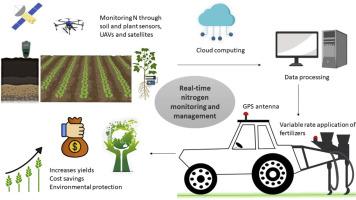Real-time nitrogen monitoring and management to augment N use efficiency and ecosystem sustainability–A review
IF 5.4
Q2 ENGINEERING, ENVIRONMENTAL
引用次数: 0
Abstract
Agriculture faces the pressing challenge of feeding a growing population while preserving the environment and natural resources. Nitrogen (N) is an essential nutrient for plant growth, and its availability in soil is a key indicator of fertility. However, the indiscriminate use of N fertilizers can lead to nutrient imbalances and soil degradation, underscoring the need for accurate and efficient soil N management. Traditional sampling and analysis methods are time-consuming and prone to error, making real-time soil N assessments crucial for effective management. Moreover, precise estimation of soil N is vital for monitoring losses, developing targeted fertilizer strategies, and enhancing crop productivity and N use efficiency. Real-time N management, which involves applying N as needed during critical growth stages, can significantly improve its usage efficiency. To achieve this, the leaf color chart offers a simple, inexpensive, and user-friendly solution for assessing N needs based on leaf color, facilitating real-time management. Furthermore, sensors and the Internet of Things (IoT) play a key role in sustainable soil management and crop productivity, contributing to the development of resilient food systems and reducing uncertainty in global food markets. Accurate, rapid, cost-effective methods for assessing soil N levels are essential to achieve these sustainable goals. This review delves into the current status, limitations, and future of N-sensing in precision agriculture, highlighting cutting-edge technologies such as real-time monitoring using remote and proximal sensors, ground-based canopy sensors, drones, and Unmanned Aerial Vehicle (UAV) equipped with high-resolution cameras or multispectral/hyperspectral sensors, Geographic Information Systems (GIS)- Global Positioning Systems (GPS) integration (GIS-GPS), data analysis, Variable Rate Technology (VRT) and crop models for precise N management. By harnessing these innovations, we can revolutionize agriculture, benefiting plant health and promoting a more sustainable future.

实时氮监测和管理,提高氮利用效率和生态系统可持续性--综述
农业面临着既要养活不断增长的人口,又要保护环境和自然资源的紧迫挑战。氮(N)是植物生长所必需的养分,土壤中氮(N)的含量是衡量肥力的关键指标。然而,氮肥的滥用会导致养分失衡和土壤退化,因此需要对土壤中的氮进行准确有效的管理。传统的取样和分析方法耗时且容易出错,因此实时土壤氮评估对有效管理至关重要。此外,精确估算土壤氮对监测损失、制定有针对性的施肥策略、提高作物产量和氮利用效率也至关重要。实时氮肥管理包括在关键生长阶段按需施用氮肥,可显著提高氮肥的使用效率。为此,叶色图提供了一种简单、廉价、用户友好的解决方案,可根据叶色评估氮的需求,从而促进实时管理。此外,传感器和物联网(IoT)在可持续土壤管理和作物生产力方面发挥着关键作用,有助于发展具有抗灾能力的粮食系统,减少全球粮食市场的不确定性。要实现这些可持续目标,必须采用准确、快速、具有成本效益的方法来评估土壤氮含量。本综述深入探讨了精准农业中氮传感技术的现状、局限性和未来,重点介绍了一些前沿技术,如利用远程和近距离传感器、地面冠层传感器、无人机和配备高分辨率相机或多光谱/高光谱传感器的无人机(UAV)、地理信息系统(GIS)-全球定位系统(GPS)集成(GIS-GPS)、数据分析、可变速率技术(VRT)和作物模型进行实时监测,以实现精确的氮管理。通过利用这些创新技术,我们可以彻底改变农业,使植物健康受益,并促进未来的可持续发展。
本文章由计算机程序翻译,如有差异,请以英文原文为准。
求助全文
约1分钟内获得全文
求助全文
来源期刊

Journal of hazardous materials advances
Environmental Engineering
CiteScore
4.80
自引率
0.00%
发文量
0
审稿时长
50 days
 求助内容:
求助内容: 应助结果提醒方式:
应助结果提醒方式:


